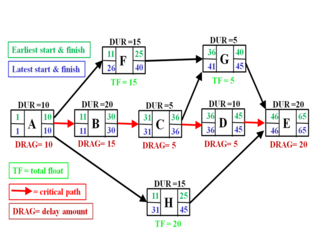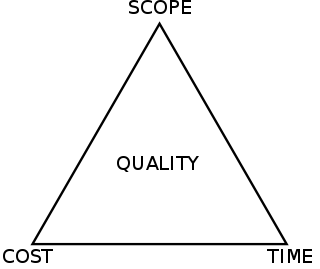Drag cost is a project management metric [1] developed by Stephen Devaux as part of the Total Project Control (TPC) approach to project schedule and cost analysis. It is the amount by which a project’s expected return on investment (ROI) is reduced due to the critical path drag of a specific critical path activity Task (project management) or other specific schedule factor such as a schedule lag or other delaying constraint. [2]
Project management is the practice of initiating, planning, executing, controlling, and closing the work of a team to achieve specific goals and meet specific success criteria at the specified time.
Return on investment (ROI) is a ratio between the net profit and cost of investment resulting from an investment of some resources. A high ROI means the investment's gains favorably to its cost. As a performance measure, ROI is used to evaluate the efficiency of an investment or to compare the efficiencies of several different investments. In purely economic terms, it is one way of relating profits to capital invested. Return on investment is a performance measure used by businesses to identify the efficiency of an investment or number of different investments.

Critical path drag is a project management metric developed by Stephen Devaux as part of the Total Project Control (TPC) approach to schedule analysis and compression in the critical path method of scheduling. Critical path drag is the amount of time that an activity or constraint on the critical path is adding to the project duration. Alternatively, it is the maximum amount of time that one can shorten the activity before it is no longer on the critical path or before its duration becomes zero.
Drag cost is computed at the activity level, but is caused by the impact at the project level due to:
1. A reduction in a project’s expected value because of later completion, or 2. An increase in a project’s cost due to its indirect costs being increased because of a longer project duration.
Indirect costs are costs that are not directly accountable to a cost object. Indirect costs may be either fixed or variable. Indirect costs include administration, personnel and security costs. These are those costs which are not directly related to production. Some indirect costs may be overhead. But some overhead costs can be directly attributed to a project and are direct costs.
Drag cost computation is often used on projects in order to justify additional project resources. For example, if a project’s expected ROI will be reduced by $5,000 for every day of duration, then an activity that has critical path drag of ten days (i.e., is delaying project completion by ten days) will have a drag cost of $50,000. If the addition of a resource that costs $10,000 would reduce the activity’s drag to five days, the drag cost would be reduced by $25,000 and the project’s expected ROI would be increased by $15,000 ($25,000 minus the additional $10,000 of resource costs).
On projects which are performed for non-monetary reasons, such as public literacy programs or emergency response, drag cost can be measured in units of reduction in citizens educated or lives lost due to the additional time taken by critical path activities. [3] Just as drag is only found on the critical path, the same is true of drag cost.
This page is based on this
Wikipedia article Text is available under the
CC BY-SA 4.0 license; additional terms may apply.
Images, videos and audio are available under their respective licenses.
Earned value management (EVM), earned value project management, or earned value performance management (EVPM) is a project management technique for measuring project performance and progress in an objective manner.
Project planning is part of project management, which relates to the use of schedules such as Gantt charts to plan and subsequently report progress within the project environment.
Critical chain project management (CCPM) is a method of planning and managing projects that emphasizes the resources required to execute project tasks. It was developed by Eliyahu M. Goldratt. It differs from more traditional methods that derive from critical path and PERT algorithms, which emphasize task order and rigid scheduling. A critical chain project network strives to keep resources levelled, and requires that they be flexible in start times.

The critical path method (CPM), or critical path analysis (CPA), is an algorithm for scheduling a set of project activities. It is commonly used in conjunction with the program evaluation and review technique (PERT). A critical path is determined by identifying the longest stretch of dependent activities and measuring the time required to complete them from start to finish.
Project management software has the capacity to help plan, organize, and manage resource tools and develop resource estimates. Depending on the sophistication of the software, it can manage estimation and planning, scheduling, cost control and budget management, resource allocation, collaboration software, communication, decision-making, quality management and documentation or administration systems. Today, numerous PC and browser-based project management software and contract management software solutions exist, and are finding applications in almost every type of business.

The program (or project) evaluation and review technique (PERT) is a statistical tool used in project management, which was designed to analyze and represent the tasks involved in completing a given project.
In project management, float or slack is the amount of time that a task in a project network can be delayed without causing a delay to:
In project management, resources are required to carry out the project tasks. They can be people, equipment, facilities, funding, or anything else capable of definition required for the completion of a project activity. The lack of a resource will therefore be a constraint on the completion of the project activity. Resources may be storable or non storable. Storable resources remain available unless depleted by usage, and may be replenished by project tasks which produce them. Non-storable resources must be renewed for each time period, even if not used in previous time periods.

Critical Chain is a novel by Dr. Eliyahu Goldratt using the Critical Chain theory of Project Management as the major theme. It is really a teaching method for the theory.

Event chain methodology is a network analysis technique that is focused on identifying and managing events and relationship between them that affect project schedules. It is an uncertainty modeling schedule technique. Event chain methodology is an extension of quantitative project risk analysis with Monte Carlo simulations. It is the next advance beyond critical path method and critical chain project management. Event chain methodology helps to mitigate the effect of motivational and cognitive biases in estimating and scheduling. It improves accuracy of risk assessment and helps to generate more realistic risk adjusted project schedules.

Operating room management is the science of how to run an Operating Room Suite. Operational operating room management focuses on maximizing operational efficiency at the facility, i.e. to maximize the number of surgical cases that can be done on a given day while minimizing the required resources and related costs. For example, what is the number of required anaesthetists or the scrub nurses that are needed next week to accommodate the expected workload or how can we minimize the cost of drugs used in the Operating Room? Strategic operating room management deals with long-term decision-making. For example, is it profitable to add two additional rooms to the existing facility? Typically, operating room management in profit-oriented health-care systems emphasizes strategic thinking whereas in countries with publicly funded health care, the focus is on operational decisions.
Quick response manufacturing (QRM) is an approach to manufacturing which emphasizes the beneficial effect of reducing internal and external lead times.

The Project Management Triangle is a model of the constraints of project management. While its origins are unclear, it has been used since at least the 1950s. It contends that:
- The quality of work is constrained by the project's budget, deadlines and scope (features).
- The project manager can trade between constraints.
- Changes in one constraint necessitate changes in others to compensate or quality will suffer.
Total project control (TPC) is a project management method that emphasizes continuous tracking and optimization of return on investment (ROI). It was developed by Stephen Devaux. It builds upon earlier techniques such as earned value management, critical path method, and program evaluation and review technique, but uses these to track and index projected project profitability as well as the more traditional cost and schedule. In this way it aims to manage projects as profit and investment centers, rather than cost centers.
A value breakdown structure (VBS) is a project management technique introduced by Stephen Devaux as part of the total project control (TPC) approach to project and program value analysis.

Spider Project is a project management software, developed by a Russian company, Spider Project Team.
Devaux's Index of Project Performance is a project management performance metric formulated by Stephen Devaux as part of the total project control (TPC) approach to project and program value analysis. It is an index that integrates the three variables of a project into a single value-based index where:






